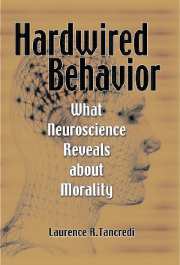Book contents
- Frontmatter
- Contents
- Preface
- Acknowledgments
- 1 Neuroscience and Morality
- 2 Morality and the Mind
- 3 Beyond the Mind Zone
- 4 The Moral Brain
- 5 Bad without Conscience
- 6 The Biology of Choice
- 7 Sex and the Single Moral Code
- 8 Brain Biology and Sex
- 9 Deception
- 10 The Biology of Money
- 11 The Bad and the Mad
- 12 Creating a Moral Brain
- Notes
- Glossary
- Index
5 - Bad without Conscience
Published online by Cambridge University Press: 13 October 2009
- Frontmatter
- Contents
- Preface
- Acknowledgments
- 1 Neuroscience and Morality
- 2 Morality and the Mind
- 3 Beyond the Mind Zone
- 4 The Moral Brain
- 5 Bad without Conscience
- 6 The Biology of Choice
- 7 Sex and the Single Moral Code
- 8 Brain Biology and Sex
- 9 Deception
- 10 The Biology of Money
- 11 The Bad and the Mad
- 12 Creating a Moral Brain
- Notes
- Glossary
- Index
Summary
At the age of twenty-nine, Ricky Green had been charged with the serial killing of two women and two men. He had sexually mutilated his victims and had attempted everything from beheading one of them to lacerating another's internal organs. Green was no mundane killer – his homicides betrayed a psychological condition far outside the crimes of passion or self-defense that the police deal with on a regular basis. I was called in to work on Green's case and to give an evaluation of his mental profile in the lawyer's hope that it would influence the sentencing phase of his trial. Psychopathy – a severe form of Antisocial Personality Disorder – immediately suggested itself to describe the particular nature of Green's crimes.
The word psychopath describes a person who lacks a conscience, the ability or sensitivity to shape a moral issue and to understand the significance of such issues, and to experience empathy. Psychopathy is derived from Greek, meaning “disease” of the “psyche” or mind. The French used to refer to people lacking conscience and the ability to conform to social norms as “moral idiots.” Sociopath is another term frequently used to describe these individuals. This term reflects a viewpoint prominent during the 1950s–1960s that environmental hardship, particularly poverty and discrimination, as well as family dysfunction induce abnormalities in socialization, which create moral “outlaws”.
The psychopath is a subset of the antisocial personality in that such individuals frequently do not meet all of the criteria for this class, but meet other criteria very strongly.
- Type
- Chapter
- Information
- Hardwired BehaviorWhat Neuroscience Reveals about Morality, pp. 46 - 68Publisher: Cambridge University PressPrint publication year: 2005



